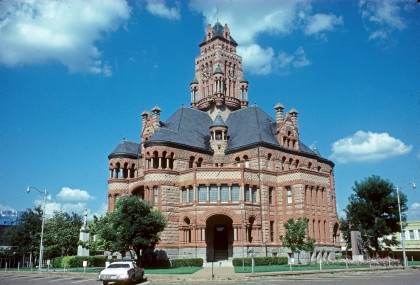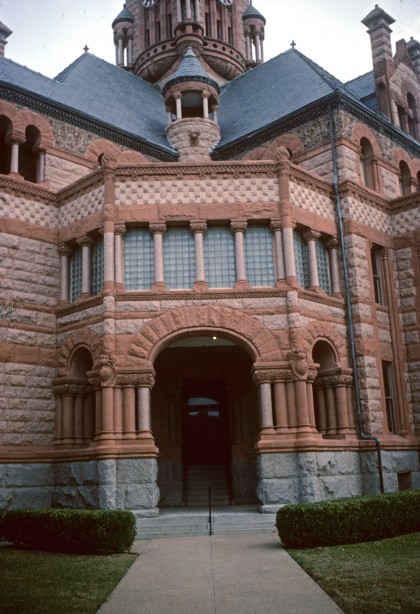Ellis County Courthouse

Some of the finest jewels of Texas architecture reside in its small towns, often little known outside their immediate communities, these buildings represent the ambitious aspirations and strong community spirit which has characterized rural Texas throughout its history. Agricultural life on the Texas prairie was a tough and rugged existence requiring firm resolve and a strong will. Settlers of rural Texas were seldom “your tired, your poor, your huddled masses” but rather a restless, independent, strong-willed breed who fought to tame a vast, indomitable land.
The architectural expression which emerged from this life matched the boldness and audacity of its inhabitants. Powerful, permanent structures not only reflected the tenacity and commitment of the populace but also reinforced the community resolve by staking a visible, lasting claim on the landscape.
No rural building type exhibits this spirit more clearly than the county courthouses which sprouted all over the state in the late nineteenth century. Spurred by an 1881 act of the Texas legislature which authorized the issuance of bonds to finance such public works, many Texas counties seized the opportunity to upgrade existing facilities to match the heightened aspirations of their communities.

The extraordinary Ellis County Courthouse in Waxahachie is the result of one such instance. The county, located just south of Dallas, had dubbed itself at the time “Queen Cotton County of the World,” but when planning began for the new building in 1894 the price of cotton was only four or five cents a pound and times were hard for farmers in the region. Newspaper accounts of the time document the impressive resolve of local leaders to build “a courthouse second to none, in point of beauty and architectural splendor” in spite of hard times.
The architect chosen for this ambitious enterprise was James Riely Gordon, an aspiring young San Antonio architect who was only thirty-one years old at the time of his commission. Marked for distinction by his triumph in a national competition for the Bexar County Courthouse three years earlier, Gordon was working on several other courthouses at the time and would eventually build sixteen such edifices in Texas and over sixty across the nation.
The Ellis County Courthouse is the most refined of a series of courthouses Gordon designed in the 1890s which were based on a cruciform plan with diagonal entrances. The prototype was designed to fit the typical Texas courthouse site, a central square city block surrounded by commercial buildings on all four sides. The scheme responded to the hot Texas climate by placing an open air shaft at the center of its cruciform composition. The shaft, with staircase below and a tower above, drew air through the surrounding offices and chambers and exhausted it out the top of the building.
The visual character of these Gordon courthouses was exuberant and eclectic. The Waxahachie confection has been variously termed Spanish, Venetian, Romanesque, Byzantine, Moorish, and Victorian. It owes an obvious debt in its geometric masonry forms, round arches, towers, turrets, and carved ornament to the particular brand of Romanesque architecture which H. H. Richardson had revived in his Trinity Church in Boston in 1873-1877. But the Gordon version is more intricate and playful than Richardson’s work and has a broader source of architectural detail. Here, the geometry is looser and more complex, and the applied ornament less systematic and traditional.
The Ellis County citizenry took great pride in the quality of construction utilized in their courthouse. The three-foot-thick masonry walls are made of the finest Texas building stone available at the time laid up in a rich pattern of colors and textures. The base is grey granite. The bulk of the walls are Texas pink granite from Burnet County similar to that used in the state capitol. Stringcourses and voussoirs are Pecos red sandstone, and smooth-finished columns are of both sandstone and granite. Porch floors are paved with two different grains of marble.
The split-face finish of the stone contributes a rugged, rough-edged quality to the building which makes it feel at home on the prairie. It is a simple, tough building from a distance. But close inspection reveals beautifully executed small-scale details. The carved stone ornament, which was crafted by three Italian stoneworkers brought over for the job, is whimsical and inventive and has been the source of numerous local legends. The building manages both the monumentality and the intimacy required of a “temple of justice” in a small agricultural community.
The degree to which the Waxahachie courthouse eloquently expresses a sense of its place is evident in several films based on agricultural life which have been shot in Waxahachie. In Places in the Heart in particular, the camera’s eye dwells on the building repeatedly, finding in its rich forms and textures an analog for rural Texas life. The building truly speaks to us, even today, about the people and the ambitions which created it.